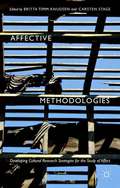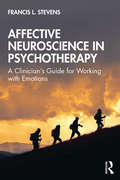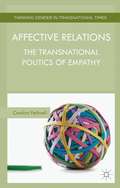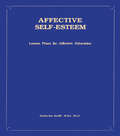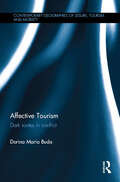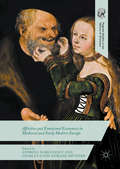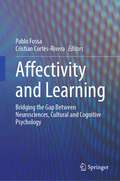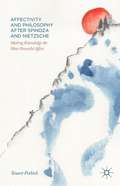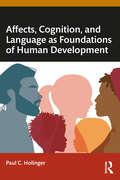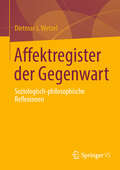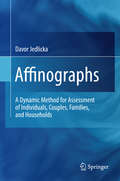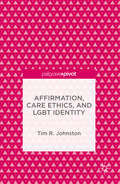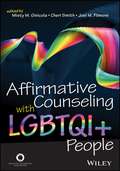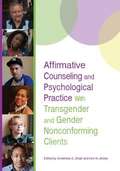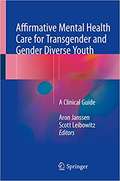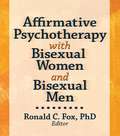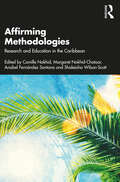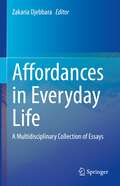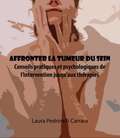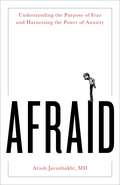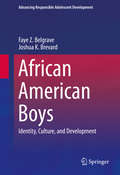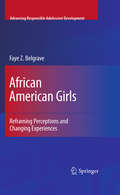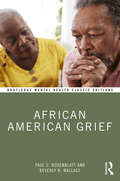- Table View
- List View
Affective Methodologies: Developing Cultural Research Strategies For The Study Of Affect
by Britta Timm Knudsen Carsten StageThe collection proposes inventive research strategies for the study of the affective and fluctuating dimensions of cultural life. It presents studies of nightclubs, YouTube memes, political provocations, heritage sites, blogging, education development, and haunting memories.
Affective Neuroscience in Psychotherapy: A Clinician's Guide for Working with Emotions
by Francis L. StevensMost psychological disorders involve distressful emotions, yet emotions are often regarded as secondary in the etiology and treatment of psychopathology. This book offers an alternative model of psychotherapy, using the patient’s emotions as the focal point of treatment. This unique text approaches emotions as the primary source of intervention, where emotions are appreciated, experienced, and learned from as opposed to being regulated solely. Based on the latest developments in affective neuroscience, Dr. Stevens applies science-based interventions with a sequential approach for helping patients with psychological disorders. Chapters focus on how to use emotional awareness, emotional validation, self-compassion, and affect reconsolidation in therapeutic practice. Interventions for specific emotions such as anger, abandonment, jealousy, and desire are also addressed. This book is essential reading for clinicians practicing psychotherapy, social workers and licensed mental health counselors, as well as anyoe interested in the emotional science behind the brain.
Affective Relations
by Carolyn PedwellExploring the ambivalent grammar of empathy where questions of geo-politics and social justice are at stake - in popular science, international development, postcolonial fiction, feminist and queer theory - this book addresses the critical implications of empathy's uneven effects. It offers a vital transnational perspective on the 'turn to affect'.
Affective Self-Esteem: Lesson Plans For Affective Education
by Katherine KrefftFirst published in 1993. Routledge is an imprint of Taylor & Francis, an informa company.
Affective Tourism: Dark routes in conflict (Contemporary Geographies of Leisure, Tourism and Mobility)
by Dorina Maria BudaThis book brings together, explores and expands socio-spatial affect, emotion and psychoanalytic drives in tourism for the first time. Affect is to be found in visceral intensities and resonances that circulate around and shape encounters between and amongst tourists, local tourism representatives and places. When affect manifests, it can ‘take shapes’ in the form of emotions such as fun, joy, fear, anger and the like. When it remains a visceral force of latent bodily responses, affect overlaps with drives as expounded in psychoanalysis. The aim of the title, therefore, is to explore how and in what ways affects, emotions and drives are felt and performed in tourism encounters in places of socio-political turmoil such as Jordan, Palestine/Israel, with a detour to Iraq. Affective Tourism is highly innovative as it offers a new way of theorising tourism encounters bringing together, critically examining and expanding three areas of scholarship: affective and emotional geographies, psychoanalytic geographies and dark tourism. It has relevance for tourism industries in places in the proximity of ongoing conflicts as it provides in-depth analyses of the interconnections between tourism, danger and conflict. Such understandings can lead to more socio-culturally and politically-sustainable approaches to planning, development and management of tourism. This ground breaking book will be of valuable reading for students and researchers from a number of fields such as tourism studies, geography, anthropology, sociology and Middle Eastern studies.
Affective and Emotional Economies in Medieval and Early Modern Europe (Palgrave Studies in the History of Emotions)
by Andreea Marculescu Charles-Louis Morand MétivierThis book analyzes how acts of feeling at a discursive, somatic, and rhetorical level were theorized and practiced in multiple medieval and early-modern sources (literary, medical, theological, and archival). It covers a large chronological and geographical span from eleventh-century France, to fifteenth-century Iberia and England, and ending with seventeenth-century Jesuit meditative literature. Essays in this book explore how particular emotional norms belonging to different socio-cultural communities (courtly, academic, urban elites) were subverted or re-shaped; engage with the study of emotions as sudden, but impactful, bursts of sensory experience and feelings; and analyze how emotions are filtered and negotiated through the prism of literary texts and the socio-political status of their authors.
Affectivity and Learning: Bridging the Gap Between Neurosciences, Cultural and Cognitive Psychology
by Pablo Fossa Cristian Cortés-RiveraThis book presents an interdisciplinary approach to the study of affectivity and human learning by bridging the gap between neuroscience, cultural and cognitive psychology. It brings together studies that go beyond the focus on cognitive-intellectual variables involved in learning processes and incorporate the study of the role played by affectivity and emotions in learning not only at educational settings but in all processes of transformation and human development, thus presenting affectivity as a catalyst and mediator of all daily learning processes.Chapters brought together in this contributed volume present both theoretical contributions and results of empirical research from different disciplines, such as neuroscience, cognitive psychology, cultural psychology, educational psychology, developmental psychology and philosophy, and are grouped into five thematic sections. The first part of the book brings together chapters discussing different aspects of the role played by affectivity in learning processes from the perspectives of cultural, educational and developmental psychology. The second part is dedicated to the role of affectivity for teachers during their training as educators and during their pedagogical practice in diverse contexts. The third part focuses on the relationship between affectivity and learning from a neuroscientific point of view. The fourth part discusses affectivity and learning in therapeutic and clinical contexts. Finally, the fifth part brings together chapters about affectivity and learning in everyday life.By bringing together this rich interdisciplinary collection of studies, Affectivity and Learning: Bridging the Gap Between Neurosciences, Cultural and Cognitive Psychology will be a valuable resource for researchers in the fields of psychology, neuroscience and education, as well as for educators and teachers interested in knowing more about the relationship between affectivity and human learning.
Affectivity and Philosophy after Spinoza and Nietzsche: Making Knowledge The Most Powerful Affect
by Stuart PethickPethick investigates a much neglected philosophical connection between two of the most controversial figures in the history of philosophy: Spinoza and Nietzsche. By examining the crucial role that affectivity plays in their philosophies, this book claims that the two philosophers share the common goal of making knowledge the most powerful affect.
Affects As Process: An Inquiry into the Centrality of Affect in Psychological Life (Psychoanalytic Inquiry Book Series #14)
by Joseph M. JonesIn this readable meditation on the nature of emotional experience, Joseph Jones takes the reader on a fascinating walking-tour of current research findings bearing on emotional development. Beginning with a nuanced reappraisal of Freud's philosophical premises, he argues that Freud's reliance on "primary process" as the means of linking body and mind inadvertantly stripped affects of their process role. Further, the resulting emphasis on fantasy left the problem of conceptualizing the mental life of the prerepresentational infant in a theoretical limbo. Affects as Process offers an elegantly simple way out of this impasse. Drawing in the literatures of child development, ethology, and neuroscience, Jones argues that, in their simplest form, affects are best understood as the presymbolic representatives and governors of motivational systems. So conceptualized, affects, and not primary process, constitute the initial processing system of the prerepresentational infant. It then becomes possible to re-vision early development as the sequential maturation of different motivational systems, each governed by a specific presymbolic affect. More complex emotional states, which emerge when the toddler begins to think symbolically, represent the integration of motivational systems and thought as maturation plunges the child into a world of loves and hates that cannot be escaped simply through behavior. Jones' reappraisal of emotional development in early childhood and beyond clarifies the strengths and weaknesses of such traditional concepts as infantile sexuality, object relations, internalization, splitting, and the emergence of the dynamic unconscious. The surprising terminus of his excursion, moreover, is the novel perspective on the self as an emergent phenomenon reflecting the integration of affective and symbolic processing systems.
Affects, Cognition, and Language as Foundations of Human Development
by Paul C. HolingerAffects, Cognition, and Language as Foundations of Human Development considers human development from the three most basic systems—affects (our earliest feelings), cognition, and language. Holinger explores how these systems enhance potential and help prevent problems, both in individuals and in societies.He begins with a focus on the affects of interest and anger and how affects provide the foundation for the sense of self and playing and creating. The author delves into cognition in the context of human relationships and infants’ remarkable capacity to understand language long before they can talk. Drawing on the work of Darwin, Freud, Stern, Basch, and the ground-breaking ideas of Silvan Tomkins, this work thus deepens the exploration into human development by integrating affects, cognition, and language. The author also uses this triad to examine two important societal issues: physical punishment, and bias, prejudice, and violence.This book will not only appeal to psychologists, psychoanalysts, psychiatrists, and social workers but is also accessible to parents, educators, and policymakers.
Affektivität und Lernen: Ein Brückenschlag zwischen Neurowissenschaften, Kultur- und Kognitionspsychologie
by Pablo Fossa Cristian Cortés-RiveraDieses Buch zeigt einen interdisziplinären Ansatz zur Untersuchung der Affektivität beim menschlichen Lernen und überbrückt dabei die Kluft zwischen Neurowissenschaften, Kultur- und Kognitionspsychologie. Es vereint Studien, die über den Fokus auf kognitiv-intellektuelle Variablen, die in Lernprozesse involviert sind, hinausgehen und die Untersuchung der Rolle von Affektivität und Emotionen beim Lernen nicht nur in Bildungssettings, sondern in allen Prozessen der Transformation und der menschlichen Entwicklung einbeziehen. Dazu wird Affektivität als Katalysator und Vermittler von täglichen Lernprozessen kritisch hinterfragt und im interkulturellen Diskurs betrachtet.Die Kapitel dieses Beitragswerkes präsentieren sowohl theoretische wie auch empirische Forschung aus verschiedenen Disziplinen wie Neurowissenschaften, kognitiver Psychologie, Kulturpsychologie, pädagogischer Psychologie, Entwicklungspsychologie und Philosophie und sind in fünf thematische Abschnitte gegliedert. Der erste Teil des Buches enthält Kapitel, in denen verschiedene Aspekte der Affektivität bei Lernprozessen aus der Sicht der Kultur-, Bildungs- und Entwicklungspsychologie erörtert werden. Der zweite Teil widmet sich der Affektivität in Bezug auf Lehrkräfte während ihrer Ausbildung und während ihrer pädagogischen Praxis in verschiedenen Kontexten. Der dritte Teil befasst sich mit der Beziehung zwischen Affektivität und Lernen aus neurowissenschaftlicher Sicht. Der vierte Teil befasst sich mit Affektivität und Lernen in therapeutischen und klinischen Kontexten. Der fünfte Teil fasst Kapitel über Affektivität und Lernen im Alltag zusammen.Durch die Zusammenstellung dieser reichhaltigen interdisziplinären Sammlung von Studien wird Affektivität und Lernen: Der Brückenschlag zwischen Neurowissenschaften, Kultur- und Kognitionspsychologie eine wertvolle Quelle für Forscher in den Bereichen Psychologie, Neurowissenschaften und Bildung sowie für Erzieher und Lehrer, diemehr über die Beziehung zwischen Affektivität und menschlichem Lernen erfahren möchten.Die Übersetzung wurde mit Hilfe von künstlicher Intelligenz durchgeführt. Eine anschließende menschliche Überarbeitung erfolgte vor allem in Bezug auf den Inhalt.
Affektregister der Gegenwart: Soziologisch-philosophische Reflexionen
by Dietmar J. WetzelAffekte, Emotionen und Gefühle sind allgegenwärtig. Sie bestimmen nicht nur unseren Alltag, sie sagen auch viel darüber aus, wer wir sind, beziehungsweise wer wir zu sein glauben. Ein «Affektregister der Gegenwart» klärt exemplarisch-systematisch über gegenwärtige und historisch gewachsene Gefühlslagen respektive affektive Zustände der Gesellschaft auf. Um dies zu veranschaulichen, werden zahlreiche Affekte und Emotionen einzeln, aber auch in ihrer Wechselwirkung soziologisch-philosophisch analysiert. Dies geschieht im Sinne einer interdisziplinär ausgerichteten Ab- und Aufklärung über die Befindlichkeiten, Erregtheiten und Ansteckungsverhältnisse, die von Affekten und Emotionen nicht nur beeinflusst, getragen und gesteuert, sondern auch von diesen erzeugt und verbreitet werden. Eine Aufarbeitung und Einsicht in unser Affektregister (und deren Manifestationen) ist unerlässlich, um zu verstehen, wie Menschen und Gruppen in bestimmten Konstellationen und Situationen empfinden, was sie zu sozialen Praktiken (unbewusst) motiviert und wie Menschen mit den dabei entstehenden Gefühlslagen bei sich und bei anderen produktiv umgehen.
Affinographs: A Dynamic Method for Assessment of Individuals, Couples, Families, and Households
by Davor JedlickaThe need for a new method for assessment and imaging of families, couples, and individuals has emerged in response to changes in family forms during the twentieth century. In the twentieth century divorce, remarriage, out-of wedlock child bearing, and alternate life styles have replaced monogamy as predominant form of marriage and the family. The methods of representation and assessment on the other hand remain based on the nineteenth century eugenics models embedded in the modern day genograms. This book is based on the premise that changes in family structure require changes in methods of representation, assessment, research, and teaching. This book introduces such a method in the form of a model named the affinograph. The affinograph provides a method which allows a greater respect for individuals, especially if their relationships contradict the preconceived institutional notions of marriage and the family. Improvement in visualizing families of various types and complexities can make affinographs an important new method that can bring together the theory, research, and application across varied disciplines that comprise family sciences.
Affirmation, Care Ethics, and LGBT Identity
by Tim R. JohnstonIn this book, Johnston argues that affirmation is not only encouragement or support, but also the primary mechanism we use to form our identities and create safe spaces. Using the work of feminist care ethics and the thinking of French philosopher Henri Bergson to examine responses to school bullying and abuses faced by LGBT older adults, he provides the theoretical analysis and practical tools LGBT people and their allies need to make all spaces, public and private, spaces in which we can live openly as members of the LGBT community. With its combination of philosophical theory and on-the-ground activist experience, this text will be useful to anyone interested in philosophy, women's and gender studies, psychology, aging, geriatrics, and LGBT activism.
Affirmative Counseling With LGBTQI + People
by Cheri Smith Misty M. Ginicola Joel M. FilmorePossessing counseling competence in serving the lesbian, gay, bisexual, transgender, queer, ques-tioning, intersex, asexual, ally, pansexual/polysexual, and two-spirited (LGBTQQLAAP-2S, henceforth referred to as LGBTQI+) communities is important, particularly because previous research has shown that large numbers of this population seek therapy. If counselors are unprepared for work with this population, they could potentially do harm to these clients. Many counselors have not received adequate training to work with affectional orientation and gender minority clients; LGBTQI+ clients are aware of this deficit in the field and prescreen therapists for safety and competence in issues of affectional orientation and gender orientation. Although many standard counseling interventions will be appropriate for work with the LGBTQI+ population, counselors need an awareness and knowledge of this population and its cultures and subcultures that extend beyond typical client concerns.
Affirmative Counseling and Psychological Practice with Transgender and Gender Nonconforming Clients
by Anneliese A. Singh Lore M. DickeyFewer than 30% of psychologists report familiarity with transgender and gender nonconforming (TGNC) clients' needs, which indicates a large gap in knowledge, skill, and competence in this area of practice. This volume provides mental health practitioners with theory-driven strategies for affirmative practice with TGNC clients of different ages, ethnicities, sexual orientations, and religious backgrounds.
Affirmative Mental Health Care for Transgender and Gender Diverse Youth: A Clinical Guide
by Aron Janssen Scott LeibowitzSimulates a range of complexity in the clinical cases to mirror real life examples.<P><P> Discusses the potential associations between gender identity and gender expression and co-occurring psychiatric conditions and how to tease them apart.<P> Written by experts in the field.<P>This unique resource offers an in-depth, comprehensive look at different types of mental health needs of transgender and gender diverse youth, how these intersect with gender identity, gender expression, and sexual orientation, and provides practical information on how to ethically, responsibly, and sensitively care for these patients.<P> Affirmative Mental Health Care for Transgender and Gender Diverse Youth: A Clinical Guide begins with three introductory chapters which contain practical information regarding assessment, psychological interventions, and the potential medical and surgical interventions that are indicated for youth with gender identity concerns. The remaining chapters are illustrated by multiple cases build around overarching chapter themes. Each case chapter opens with broad questions applicable to clinical practices, while the cases themselves focus on a particular co-occuring mental health condition. The case chapters are structured with intersectionality in mind, including elements of ethnic, racial, and cultural diversity, and the patients range over the full developmental spectrum, from pre-pubertal children to older adolescents. Chapter cases range in complexity as well, to provide readers with the tools they need to evaluate patients, and to assist in the decision of which presenting factors to prioritize in treatment at which time. Ending each chapter are clinical take-home messages, closing with additional practical knowledge that can be applied to other cases providers may see in their own practices.<P> Written by expert clinicians in the field, Affirmative Mental Health Care for Transgender and Gender Diverse Youth: A Clinical Guide is an ideal resource not only for child and adolescent psychiatrists, but for clinicians across all mental health disciplines working with gender non-conforming youth, and who are interested in providing informed, affirmative, and intersectional care.
Affirmative Psychotherapy with Bisexual Women and Bisexual Men
by Ronald C. FoxLearn the latest practical-and bisexually affirmative-approaches to helping bisexual clientsClinical work with bisexual clients has conceptually shifted beyond the exclusive emphasis on either straight or lesbian and gay issues. There are still, however, too few psychotherapists who provide affirmative psychotherapy specific to bisexual concerns. Affirmative Psychotherapy with Bisexual Women and Bisexual Men addresses the issues of bisexuals with an accepting and affirmative perspective, providing therapists with the latest viewpoints, strategies, and research to effectively treat bisexual clients. Leading authorities with affirmative-to-bisexuals perspectives discuss problems specific to bisexuals and their lifestyles, with an eye toward providing practical, effective therapy. Unique bisexual lifestyle concerns are examined, such as transgender issues, polyamory, older bisexual women and men, and cultural differences, while providing an emphasis on cultivating well-being and a sense of community in bisexual clients.Affirmative Psychotherapy with Bisexual Women and Bisexual Men sensitively avoids the double standard long held by therapists clinically treating heterosexual or lesbian and gay individuals, showing that an affirmative viewpoint is valid and crucial for the effective treatment of bisexuals. This source clearly explains practical strategies and discusses the latest research on bisexual issues such as age, culture, heterosexual and bisexual mixed couples, and the polyamorous lifestyle with appropriate acceptance and understanding. The book also explores useful ways to develop successful health and support services specific to bisexual needs.Topics in Affirmative Psychotherapy with Bisexual Women and Bisexual Men include: affirmative psychotherapy techniques specific to bisexual women and bisexual men need for validation of bisexuality ways for clients to come to terms with their bisexuality practical value-and shortcomings-of the main therapeutic schools in providing effective psychotherapy transgender bisexuality, with illustrative case studies needs and issues of African-American bisexual clients bisexual aging issues counseling heterosexual spouses of bisexual women and men therapy approaches for clients who are bisexual and polyamorous recognizing and addressing the specific needs of different sub-groups of bisexual people and more! Affirmative Psychotherapy with Bisexual Women and Bisexual Men is a crucial addition to the literature of bisexual psychotherapy and is invaluable to counselors, psychotherapists, marriage and family therapists, social workers, psychiatrists, sex therapists, researchers, and educators in the fields of psychology, sociology, anthropology, sexuality, sex education, adolescent and adult development, and community mental health.
Affirming Methodologies: Research and Education in the Caribbean
by Camille NakhidAffirming Methodologies: Research and Education in the Caribbean centres local and indigenous ways of knowing in research and education praxis in the Caribbean. The research methodologies and pedagogies are presented in this book within an Affirming Methodologies framework. They bring forward localized epistemologies whereby Caribbean ways of being and knowing are affirmed, and the expected western hierarchies between researcher and researched are removed. The chapters present approaches to knowledge construction and knowledge sharing based on practices, lived experiences, traditions, language patterns, and rituals of Caribbean communities. The importance of an Affirming Methodologies approach is demonstrated, and the characteristics of culturally affirming research methodologies and pedagogies in diverse environments including Cuba, Trinidad and Tobago, Jamaica and the Caribbean diaspora in Aotearoa New Zealand and Canada are explored and presented. Grounded on an understanding of the authors’ Caribbean positionality, ontological distinctions within the Caribbean research context are considered. This book moves forward from a decolonizing methodology approach, and, as such, the chapters are written, not in opposition to, or tested against Eurocentric approaches to research, but deeply rooted in a Caribbean ethos. This book will engage researchers (both qualitative and quantitative), postgraduate students, academics, practitioners, policymakers, community workers, and lay persons who seek to employ culturally relevant local and indigenous research approaches in their work. Each chapter offers practical suggestions on the 'how' of research practice, making them accessible, relevant, and flexible for novice and seasoned researchers alike.
Affordances in Everyday Life: A Multidisciplinary Collection of Essays
by Zakaria DjebbaraThe concept of affordances is being increasingly used in fields beyond ecological psychology to reveal previously unexplored interdisciplinary relationships. These fields include engineering, robotics, artificial intelligence, neuroscience, urban theory, architecture, computer science, and much more. As the concept is adapted for its relational meaning between an agent and the environment, or object, the meaning of the term has changed to fit the customs of the adapting field. This book maps the different shades of the term and brings insights into how it is operationalized by providing short accessible essays regardless of background. Each contribution addresses big questions around this topic such as the application of the concept on ongoing research, how to measure or identify affordances, as well as other reflective questions about the future of affordances in the field. The book is envisioned to be read by non-experts, students, and researchers from several disciplines, and fills the need for summarization across disciplines. As the many adaptations flourished from the same psychological concept, this book also aims to function as a catalyst and motivation for reinterpreting the concepts for new directions. Compared to existing books, this book aims not to span the vertical dimension of field by taking a deep dive into a niche-field—instead, this book aims to have a wide horizontal span highlighting a common concept shared by an increasing number of fields, namely affordances. As such, this book takes a different approach by attempting to summarize the different emerging applications and definitions of the concept, and make them accessible to non-experts, students, and researchers regardless of background and level.
Affronter la tumeur du sein
by Laura Pedrinelli Carrara Sanja AudarCe livre se veut être une contribution compréhensive et un soutien pour les femmes qui combattent le cancer du sein. Vous trouverez là-dedans de différents chapitres expliquant les typologies diverses de traitements et d’examens de diagnostic, les droits de la personne malade, les associations bénévoles, les aspects psychologiques, les symptômes divers avec les modalités à les alléger naturellement, et autres sujets. L’intention est d’aider la femme dans une période où même le choix du pyjama ou de la chemise de nuit pour l’intervention chirurgicale peut se manifester comme une décision complexe, en supposant qu’elle traverse une période avec d’innombrables incertitudes, situations émotionnellement pénibles, et faire une décision, aussi simple soit-elle, se traduit par le énième problème. Au niveau psychologique, les sujets abordés, parmi les autres, concernent la communication avec la famille et les amis, la gestion du stress, et les méthodes probantes pour surmonter cette crise. Dans le chapitre dédié aux thérapies oncologiques une partie est consacrée au choix de la perruque ou autres couvre-chefs et à la gestion des symptômes.
Afraid: Understanding the Purpose of Fear and Harnessing the Power of Anxiety
by Arash JavanbakhtSELF-HELP/ANXIETY. A psychiatrist and neuroscientist describes fear and anxiety in our brain and body and how they color many aspects of a modern human's life. In a way that is accessible to the public, he explains why we love to be scared; the link between bravery, meaning, aggression, creativity, and fear; and the diseases of fear and anxiety and how we manage them. ARASH JAVANBAKHT, MD, is director of the Stress, Trauma, and Anxiety Research Clinic STARC) at Wayne State University, School of Medicine. He is renowned for his research of biology and innovative technologies for treatments of anxiety and PTSD. Dr. Javanbakht's public scholarly work has been read by millions and featured on CNN, NPR, BBC, PBS, Scientific American, and many others.
African American Boys: Identity, Culture, and Development (Advancing Responsible Adolescent Development)
by Faye Z. Belgrave Joshua K. BrevardThis book discusses current research on identity formation, family and peer influences, risk and resilience factors, and concepts of masculinity and sexuality in African American boys. Sorting out genuine findings from popular misconceptions and misleading headlines, this concise and wide-ranging reference covers the crucial adolescent years, ages 11-16, acknowledging diversity of background and experience in the group, and differences and similarities with African American girls as well as with other boys. In addition, the authors review strengths-based school and community programs that harness evidence and insights to promote pro-social behavior. Featured areas of coverage include: The protective role of ethnic identity and racial socialization. Family management, cohesion, communication, and well-being. Development and importance of peer relationships. Health and well-being. Theoretical perspectives on educational achievement. Factors that contribute to delinquency and victimization. What works: effective programs and practices. African American Boys is an essential resource for a wide range of clinicians and practitioners - as well as researchers and graduate students - in school and clinical child psychology, prevention and public health, social work, mental health therapy and counseling, family therapy, and criminal justice.
African American Girls: Reframing Perceptions and Changing Experiences (Advancing Responsible Adolescent Development)
by Faye Z. BelgraveThe teenage years can be exciting for girls, as they develop into young women and anticipate their future. For some, however, this developmental stage may be tempered by increased risks for teen pregnancy, school failure, and some health problems. African American Girls: Reframing Perceptions and Changing Experiences explores not only the challenges and stressors confronting this unique population, but also the strengths and resiliencies used to meet them. Examining prevailing trends while avoiding simplistic generalizations, the book is both descriptive (e.g., explaining similarities and differences with girls of other ethnicities and African-American boys in critical areas) and useful (e.g., providing concrete guidelines for professionals working to support prosocial development and prevent risky behaviors). This unique volume: addresses salient issues of self and identity, examines crucial domains, such as relationships, achievements and expectations, and issues that have a major impact on health and well-being, offers practical recommendations and resources for working with African-American girls during the period when life experiences and decisions are most likely to affect adult outcomes, discusses the lives of girls from diverse families, communities, and circumstances, explores the influences of family, peers, community, and cultural traditions, features sample activities for promoting positive development and includes quotations reflecting the perspectives of the girls in their own words. African American Girls is an essential resource for a wide range of professionals, including clinical, child, and school psychologists, counselors, therapists, and social workers. Whether one's specialty is prevention, intervention, education, or research, this book is a must-have volume.
African American Grief (Routledge Mental Health Classic Editions)
by Paul C. Rosenblatt Beverly R. WallaceAfrican American Grief is a unique contribution to the field, both as a professional resource for counselors, therapists, social workers, clergy, and nurses, and as a reference volume for thanatologists, academics, and researchers. The classic edition includes a new preface from the authors reflecting on their work and on the changes in society and the field since the book’s initial publication. This work considers the potential effects of slavery, racism, and white ignorance and oppression on the African American experience and conception of death and grief in America. Based on interviews with 26 African Americans who have faced the death of a significant person in their lives, the authors document, describe, and analyze key phenomena of the unique African American experience of grief. The book combines moving narratives from the interviewees with sound research, analysis, and theoretical discussion of important issues in thanatology, as well as topics such as the influence of the African American church, gospel music, family grief, medical racism as a cause of death, and discrimination during life and after death.
